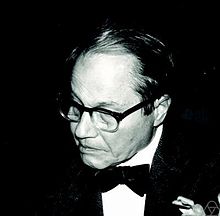Frederick Gehring
Frederick William Gehring (born August 7, 1925 in Ann Arbor ; † May 29, 2012 ibid) was an American mathematician who dealt with function theory ( quasi-conformal maps ).
Live and act
Gehring's father was a journalist and music critic, his mother the daughter of a physics professor at the University of Michigan and a German teacher at the university. Gehring initially wanted to study at the Massachusetts Institute of Technology (MIT), but then signed up for the US Navy during World War II , which allowed him to study electrical engineering and mathematics at the University of Michigan (bachelor's degree in both subjects in 1946). After the war, he made his master's degree in mathematics at the University of Michigan in 1949 and then went to Cambridge University as a Fulbright scholar , where he a. a. heard from John Edensor Littlewood and received his PhD from John Charles Burkill in 1952 ( Study of the th power variation ). After receiving his doctorate, he was a Peirce Instructor at Harvard University .
From 1955 he was back at the University of Michigan , where he received a full professorship in 1962 and stayed for the rest of his career until his retirement in 1996. 1973–1975, 1977–1980 and 1981 to 1984 he was chairman of the faculty and in 1987 he became "THHildebrandt Distinguished University Professor". Gehring was mainly concerned with the theory quasi conformal mappings, which he carried a study period 1958-59 (as a Guggenheim Fellow) at the University of Helsinki in Olli Lehto was guided to. He then worked with Albert Pfluger at the ETH Zurich in 1959/60 .
Gehring developed the theory of quasi-conformal mappings in more than two dimensions and was instrumental in promoting the applications of quasi-conformal mappings in other areas of mathematics such as the theory of partial differential equations , geometric topology , complex dynamics, discrete transformation groups, and Riemannian geometry . Together with mathematicians from the Finnish school in particular, he proved in the 1950s and 1960s the equivalence of geometrical, metric and analytical definitions of quasi-conformal mappings in two and more dimensions. Gehring was strongly influenced by the Finnish school of function theory and built his own American school of function theorists at the University of Michigan.
In 1989 he was elected to the National Academy of Sciences and the American Academy of Arts and Sciences . In 2006 he received the Leroy P. Steele Prize for Lifetime Achievement. He also received the Humboldt Research Award . He holds honorary doctorates from the University of Helsinki, the Norwegian Technical University and the University of Jyväskylä in Finland. With Lars Ahlfors he was one of the editors of Oswald Teichmüller's collected works in 1982 . He was invited speaker at the International Congress of Mathematicians (ICM) in 1986 in Berkeley ( Quasiconformal mappings ), 1962 in Stockholm ( Extremal length definitions for the conformal capacity of space rings ), 1966 in Moscow ( Extension theorems for quasiconformal mappings in n-space ) and 1974 on the Vancouver ( Some metric properties of quasiconformal mappings ).
In 1953 he married the microbiologist Lois Bigger, whom he met in Cambridge and with whom he has two sons.
literature
- Peter Duren, Juha Heinonen , Brad Osgood, Bruce Palka: Quasiconformal Mappings and Analysis: A Collection of Papers Honoring FW Gehring. Springer-Verlag, Berlin 1998, ISBN 038798299X .
- Peter Duren, FW Gehring: A Mathematical Biosketch , Computational Methods and Function Theory, Volume 14, Issue 2–3 (October 2014), pages 161–167. (Special issue in memory of Gehring)
Web links
- Notices AMS for the Steele Prize 2006 to Gehring (PDF file; 384 kB)
- A quasiconformal life: Celebration of the legacy and work of FWGehring : Conference in honor of Gehring, link to numerous photos by Gehring
| personal data | |
|---|---|
| SURNAME | Gehring, Frederick |
| ALTERNATIVE NAMES | Gehring, Frederick William |
| BRIEF DESCRIPTION | American mathematician |
| DATE OF BIRTH | August 7, 1925 |
| PLACE OF BIRTH | Ann Arbor |
| DATE OF DEATH | May 29, 2012 |
| Place of death | Ann Arbor |

